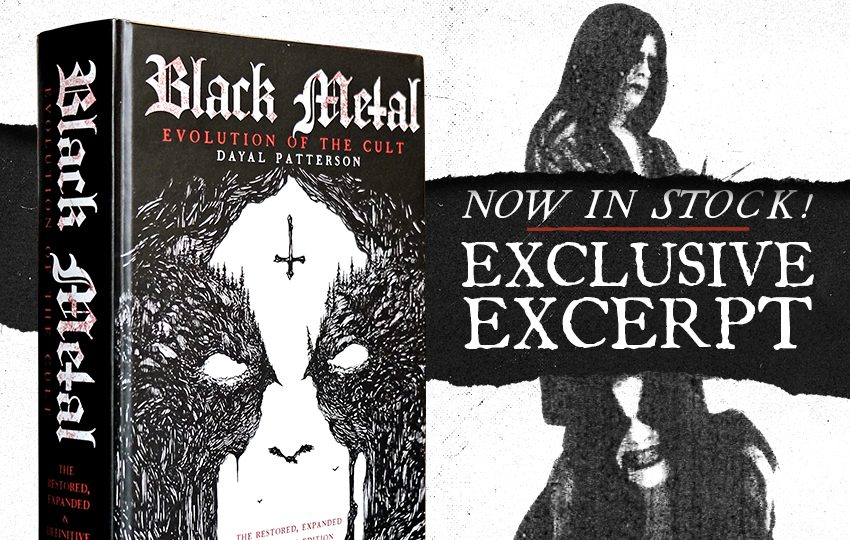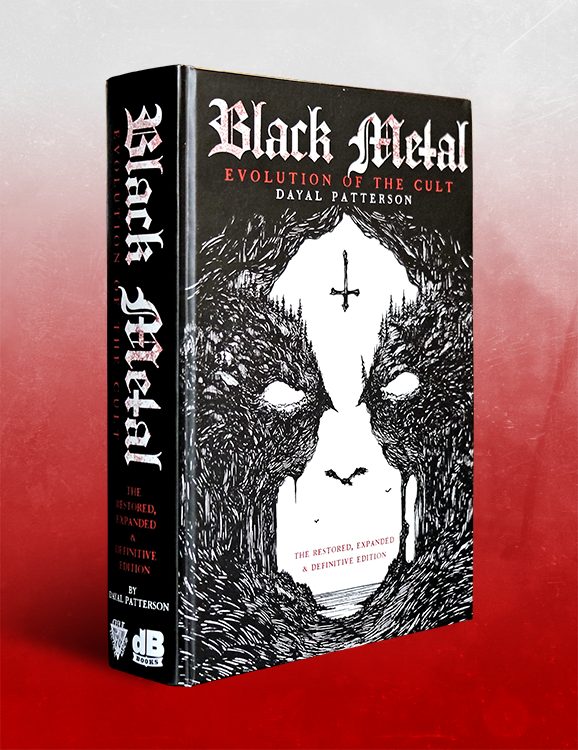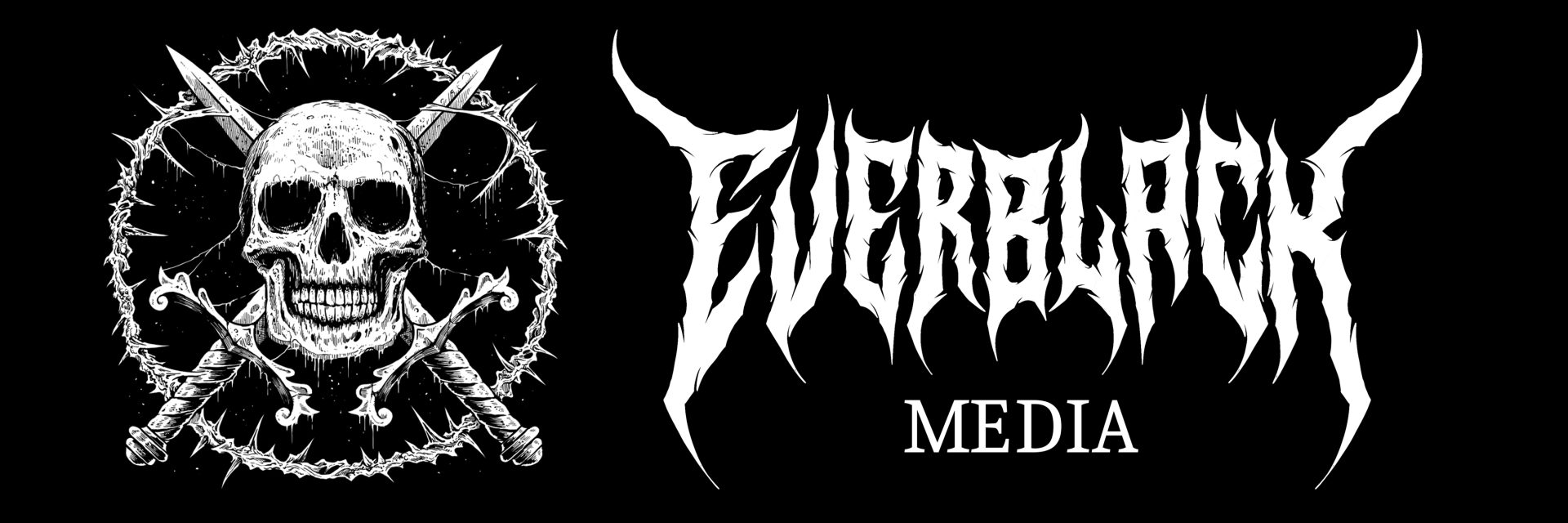
Today (January 19th) Decibel Books celebrates the official release of Black Metal: Evolution of the Cult—Restored, Expanded & Definitive Edition by revealing the first excerpt from this massive hardcover black metal history (over 800 pages!), authored by Dayal Patterson. The following passage (also online here) transports readers to—you guessed it—Norway: the waning days or the underground death metal craze, the messy beginnings of the second wave of black metal and the genesis of scene legends Immortal.
– EXCERPT –
One of the earliest bands to emerge during the rebirth of black metal in Norway, Immortal have gone on to become one of the genre’s most popular and iconic artists, and probably the most recognizable to those outside of the scene. Despite creative conflict and commercial success, Immortal’s music stays remarkably true to the vision crystalized on their early albums, one inspired by the legends of the 1980s, yet nevertheless bearing the combination of searing aggression and rich atmosphere that characterized the 1990s.
For many years, Immortal was centered on two men: guitarist Harald Nævdal (who adopted the pseudonym Demonaz Doom Occulta) and vocalist/bassist Olve Eikemo (Abbath Doom Occulta), both of whom grew up in the west of Norway. Like so many of their peers, the two had discovered heavy metal in their childhood—thanks in no small part to KISS’s highly effective promotional campaign—and hungrily explored the genre as they grew older.
“It was a very small community,” recalls Demonaz of his youth in an interview I conducted in 2023. “I was tape-trading demos, and that opened up the world and offered new possibilities, because in Norway it was very hard to get music. Whenever I wanted an album, I had to order from the U.K. or Sweden; in Norway there was nothing. You had to trust the reviews in the fanzines, and there was also a Swedish record club where you would get a monthly magazine; you saw a cover and hoped the album was great. Sometimes it was horrible. You bought five at a time—it was cheaper because of the postage—and there would be one or two that were killer; the others you just throw away or swap for something else.
“Coming from the place I did outside Bergen, there was nobody listening to rock ‘n’ roll. I had no friends, none whatsoever, that were listening to the same music when I was 12 years old listening to Black Sabbath, or when I was 10 listening to the Rolling Stones, trying to play ‘Satisfaction’ on a borrowed acoustic guitar… which was impossible.”
Demonaz would meet a like-minded soul in the form of Jørn Tunsberg, and together with drummer Jan Atle “Padden” Åserød—and initially a guitarist named Truls Kvernhusvik—they would begin creating their own music, Demonaz handling vocals and guitars, Tunsberg on drums and Padden on bass. Initially known as Sacrecy, and then Amputation, the band recorded two demos—Achieve the Mutilation and Slaughtered in the Arms of God, released in 1989 and 1990 respectively—Tunsberg and Padden curiously swapping instruments for the second demo.
“I got to know Demonaz at school when he moved to my area,” recalls Tunsberg. “We were 15 or 16 years old. We started to hang out a lot and started Sacrecy, then Amputation. Then when we were around 17 or 18, we met Abbath and his friends—they played in Old Funeral, and we started to hang out with them around ’88/’89.”
Like Sacrecy/Amputation, Old Funeral were a death metal band that had formed in 1988 and released demos in 1989 and 1990. The two bands crossed paths regularly since Padden was the drummer for Old Funeral and Demonaz played guitar in the band for a time, while Abbath would eventually contribute to Amputation. The local scene was very small, and Bergen was far from the metal-centric city it is today, meaning support was in somewhat short supply.
“People were saying, ‘You can never go anywhere with this music,'” Demonaz sighs. “That’s what you always were told, and that was just adding fuel to the fire, I think that was helping us in a way to work harder. I remember I was driving myself and Abbath to the rehearsal place—I’m three years older and he didn’t have a license yet—and when we arrived, there were some people coming to watch us because they heard that there were some people playing in the basement. And they didn’t understand it. They were asking, ‘What kind of music is this?’ They thought we were just fooling around maybe, I don’t know. But there was a contest half an hour from the rehearsal place, this Norwegian music contest, and there were just rock bands and punk bands, no [other metal] bands. We came in, we’d rehearsed all we could, and we won the fucking contest. It was like, ‘What happened?!'”
Padden would soon end up “out of the picture,” and so Demonaz, Tunsberg and Abbath formed Immortal, taking on a new drummer, Gerhard Herfindal, then known as Gædda and soon Armagedda. The first result of this union was the band’s only demo, a self-titled effort recorded at a youth club on July 5, 1991 and released soon after. Featuring cover art by Dead of Mayhem and a logo by Jannicke Wiese-Hansen (soon to be known for her work with Burzum and Enslaved), the music was undeniably death metal in nature, with deep guttural vocals—courtesy of Abbath, who immediately became the band’s frontman—pummeling drums and plenty of simple, nasty riffs.
“Morbid Angel’s ‘Thy Kingdom Come’ demo was a huge inspiration,” says Demonaz. “Also, ‘Altars of Madness’ is my favorite death metal album ever, or one of them. It has this haunting voice, those great guitar riffs, and the songs are just flowing; there is some sort of magic in the production, near to perfection in death metal. Also, the first Entombed album—very different to what I do, but it has some sort of heavy death metal rock ‘n’ roll type of songs. Death metal was very inspiring in the beginning when we made the demos, no doubt about it.”
Released just three months later on Listenable Records, the band’s self-titled 7-inch demonstrated a marked shift from death to black metal, reflecting the wider conversion taking place in the Norwegian underground. Listening today, the riffs themselves are pretty chuggy and death metal in flavor, but the cutting treble-heavy guitar sound (mirrored by the higher-pitched and more malevolent-sounding vocals) hints at the new direction to come. The band was also using pseudonyms for the first time and had stripped down to a three-piece, Tunsberg leaving to play in Old Funeral before going on to form the Viking black metal band Hades.
The band was promptly signed by another French label, Osmose Productions, which issued debut full-length Diabolical Fullmoon Mysticism in July of 1992, making it one of the very first Norwegian black metal albums. Though the songs still bear some remaining traces of death metal, the album offered a much clearer picture of what was to come, its songs characterized by demonic shrieked vocals and a combination of long, epic riffs and shorter, busier hooks. The drums generally stick to an upbeat, galloping rhythm à la Viking-era Bathory, the songs periodically dipping into nastier, more foreboding passages, the trio piling on the atmosphere wherever possible. The overall experience is a blend of ’80s and ’90s black metal, with a few hints of death metal and thrash, and remains a popular opus.
“My main inspiration, my heroes, were Conan the Barbarian, Quorthon and Tom G. Warrior,” laughs Demonaz. “And, of course, Cronos from Venom. That was a magic time for these three-piece bands. The first time I saw the ‘Blood Fire Death’ inner sleeve with the three-piece band, I thought, ‘This is it; the three-piece band is the shit.’ That was the main influence, not only musically. The Bathory style of singing and most of the riffs came from early Bathory also—I was born in 1970 and I think ‘The Return……’ was the first Bathory album I bought, and the expression he made on ‘The Return……’ with the full moon… obviously, ‘Diabolical Fullmoon Mysticism’ was inspired by that.
“But we weren’t good enough musicians, we learned on the way. We weren’t that technical; we could play, but we couldn’t play like Slayer with a very technical style. But we had a driving force. We were very motivated, and you can learn a lot from that, so we focused on the writing and finding the right moods for the album. Bathory was a big influence, but also Manowar—even if it doesn’t sound like Manowar, you can feel the influence there—and bands like early Metallica, some riffs inspired from Celtic Frost, it was a mix of all of that.”
Though the band had not quite found the distinctive sound for which they would ultimately be known, many of the fundamentals were already in place, not least in the overall aesthetic. Having a corpsepainted band photograph on the cover would become a hallmark of the group (and to some degree, the genre)—for many years to come; and lyrically and thematically, the band was already largely eschewing the Satanism of their peers, despite “Unholy Forces of Evil” featuring talk of burning pentagrams and the devil.
For the most part, though, the band painted fantastic tales of wintry Northern landscapes and sinister sorcery on songs such as “The Call of the Wintermoon,” “Cryptic Winterstorms” and “A Perfect Vision of the Rising Northland.” They also openly rejected Satanism in interviews, a fairly ballsy move at the time, especially for a group approved by Euronymous. “I don’t believe in ‘Satan’ himself,” Abbath stated in 1993 in Black Montanas zine. “I have never seen him and I don’t think anyone ever has. I believe in the sign of evil: pentagrams, inverted crosses, etc. It stands for the evil in life, that’s my opinion.”
“We never were inspired musically by the other Norwegian bands; that was a wrong thing to do in a way,” says Demonaz. “When we did our first album, it was more inspired by the surroundings. I never wanted the lyrics to be political or religious; I wanted to find an expression, and I found it on ‘The Return……’ album by Bathory, where he was singing about the cold and the wind and all that. I thought that would be our signature, to sing about where we came from, the nature and everything. Of course, the makeup was a KISS/Mayhem thing. Mayhem had already started to do that, so that was an influence, but not the music.”
This fascination with cold Nordic landscapes would be crystallized in the “Blashyrkh” concept, which has provided a thematic base for every album that followed. The word actually only appears once in the lyrics on each of the first two albums, but the third LP, 1995’s Battles in the North, explores the idea much more explicitly in the popular track “Blashyrkh (Mighty Ravendark),” embedding this mythical land into the consciousness of fans. Later albums would feature the songs “Gates to Blashyrkh” and “Blashyrkh My Throne,” the band also releasing a live album entitled The Seventh Date of Blashyrkh (a sly nod to heroes Venom) and a box set called Under the Banner of Blashyrkh. Even the early band address started with the line “Immortal ‘At the Gate of Blashyrkh’ Fan-Club.”
“From the beginning I wanted the band to be a phenomenon, to be different from the others,” considers Demonaz. “So doing Immortal, it was an obvious thing from the start. I made this word ‘Blashyrkh,’ which means ‘the realm of the dark and cold.’ There is a word for winter, there’s a word for snow, for wind, for frost, but there was never a word for all this and the dark together, so this word was to describe this feeling, this dark cold atmosphere which nobody can touch, which is a bit uncontrollable. This is nature; we can control most things, but we can’t control nature. The universe is powerful, and it doesn’t care about us. We are on this earth, traveling through this universe which doesn’t care about us, which is interesting, and I always thought that would be the Immortal perspective.
“But there was never a mission behind it. I never try to preach anything, what people should do with their lives or what they should believe in. It’s part of how we present the band, and it’s also for the listener to escape into that mood. It’s something you can only find in Immortal, and I think that’s important for a band: to have a signature, to believe in what you do and stay true to it and just try to improve it. One fan told me, ‘When I want to listen to Immortal, nothing else works; it’s like I can’t find that in any other band,’ and maybe that’s because I stick to that recipe that became the signature of an Immortal song. And I still want to do that, and I still try and do that better and better and better.”
Black Metal: Evolution of the Cult—Restored, Expanded & Definitive Edition is available exclusively in North America now via:
https://store.decibelmagazine.

